This time of year(Autumn/winter) is full of complaints, to be honest. Too many leaves clutter up the place. I am mildly sympathetic, but leaves have been falling from the first trees for about 95 million years. They’ve been here a lot longer than us and this annual act of falling leaves is massively important, helping the tree to conserve energy, nurturing the soil below, and providing numerous wildlife habitats on the ground. So my patience with complaints is a little limited, sorry!
You might not care much about ancient history or the wider picture, but there are many modern and direct benefits to having more trees in your neighbourhood.
By urban trees, in this article, we’re mostly talking about street trees, but it can also mean very small woodlands and trees in gardens.
Tree Cover in Wigan Borough
Just how widespread are trees in Wigan?
Urban tree cover in Wigan’s urban areas is quite varied, with minimal or average compared to the UK average of 18%. Some areas in the Borough just 10%, whilst some are 28%. The ideal tree cover is considered to be 20%
Have a look at this interactive map yourself.
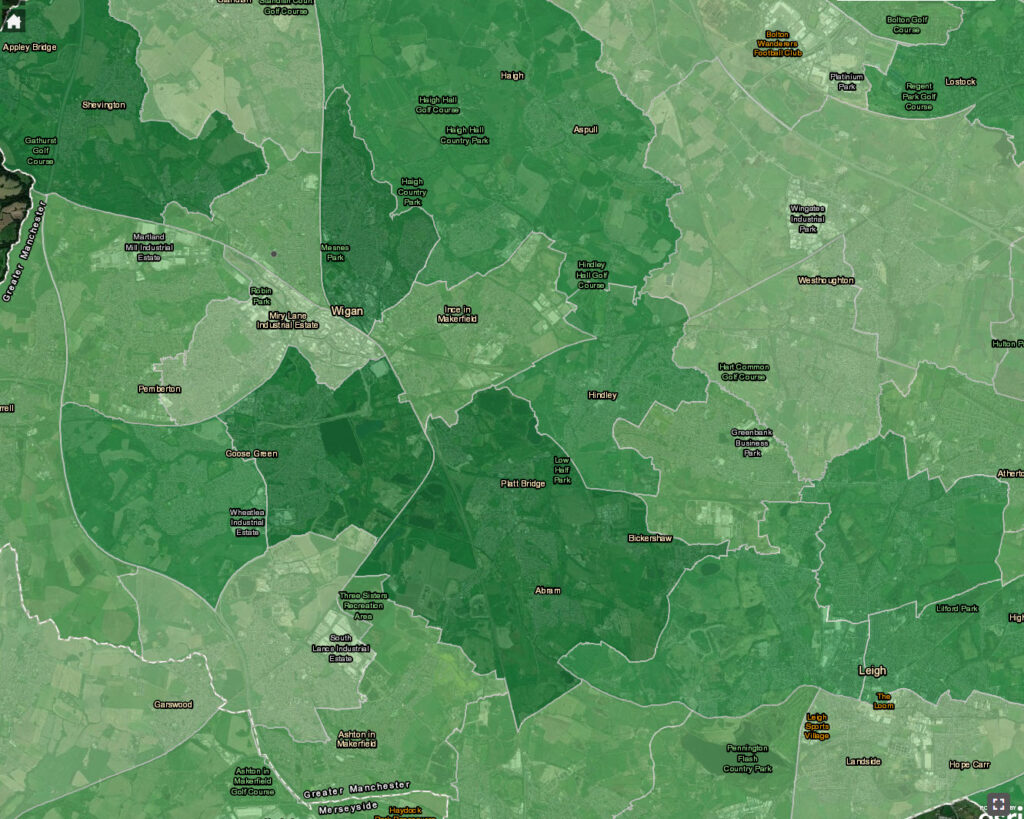
This map blow is a local Greeness Grid. Dark red means over 90% manmade cover on the ground, and purple is 0-10% And the rest is a scale in between.
You can see our town centres are completely filled with concrete, with the majority being 80% and above. And even in the suburban areas many are 50% and above man made materials. Explore the Greenspace map here – my neighbourhood is 60% concrete and above. Generally speaking, we’re missing out on a lot of greenery and trees in our urban centres.
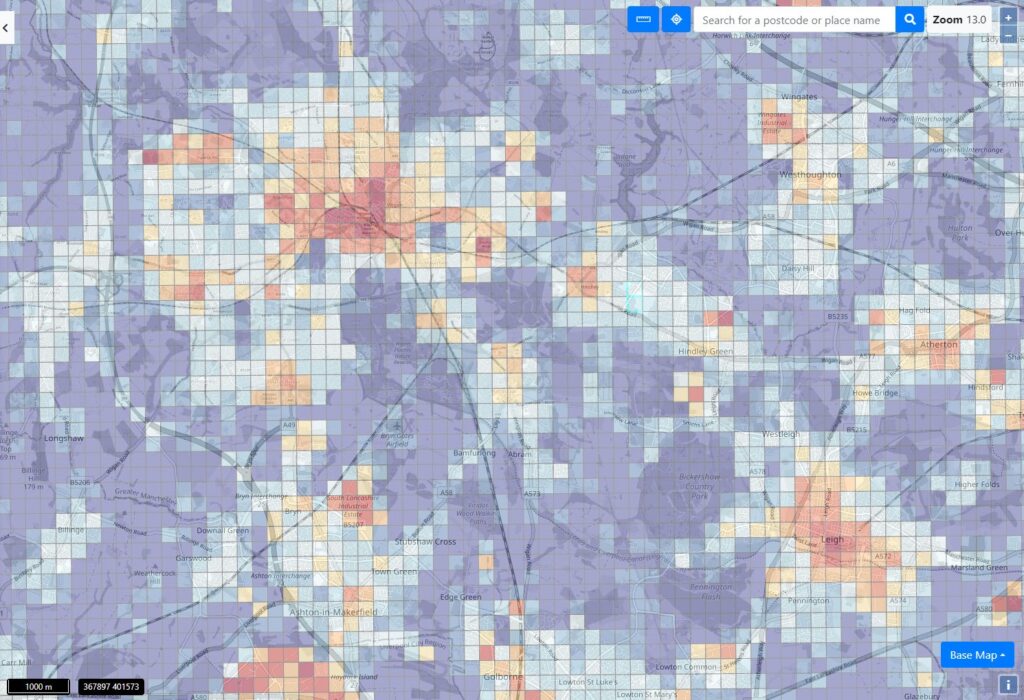
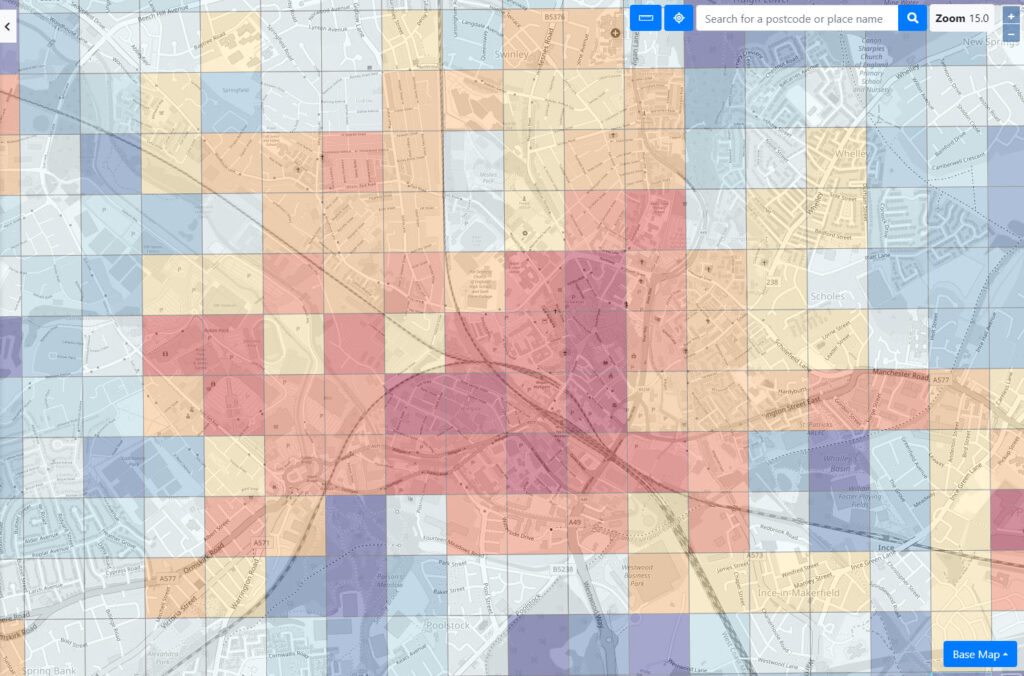
Trees Reduce flooding
Large trees reduce localised flooding in several ways.
Firstly, rain hitting the leaves of a large tree stop so many raindrops from hitting the ground in the first place. A lot of those drops will evaporate away. The trunk also channels rain down directly towards the roots. Then the roots absorb water. So there is little surface runoff compared to rain hitting the concrete pavement and running right down the road into our overflowing drains.
When trees are removed, there is up to 55% surface water runoff, compared to 20% with trees and grass.
We’ve written about flooding in Wigan before; here are some tips to reduce flooding in your area.
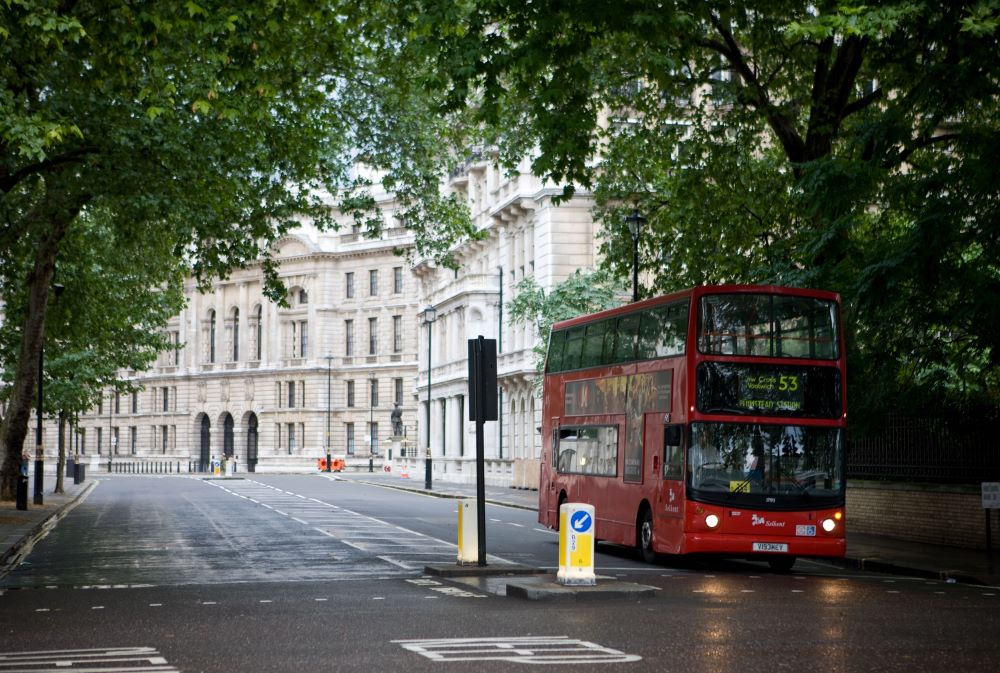
Mental and physical health benefits
Seeing greenery outside your window has some significant mental health benefits; this is why we always encourage adding some plants to your front yard even if you don’t have a front garden.
But visible street trees also have the same effect and are known to reduce stress and anxiety – and even lower blood pressure.
We’re also more likely to go outside in a tree-lined street and therefore benefit from a bit of physical health from the movement, as well as exposure to sunlight, which aids sleep.
Trees are also noise-reducing, so the added benefits of hearing less traffic outside your house can’t be ignored.
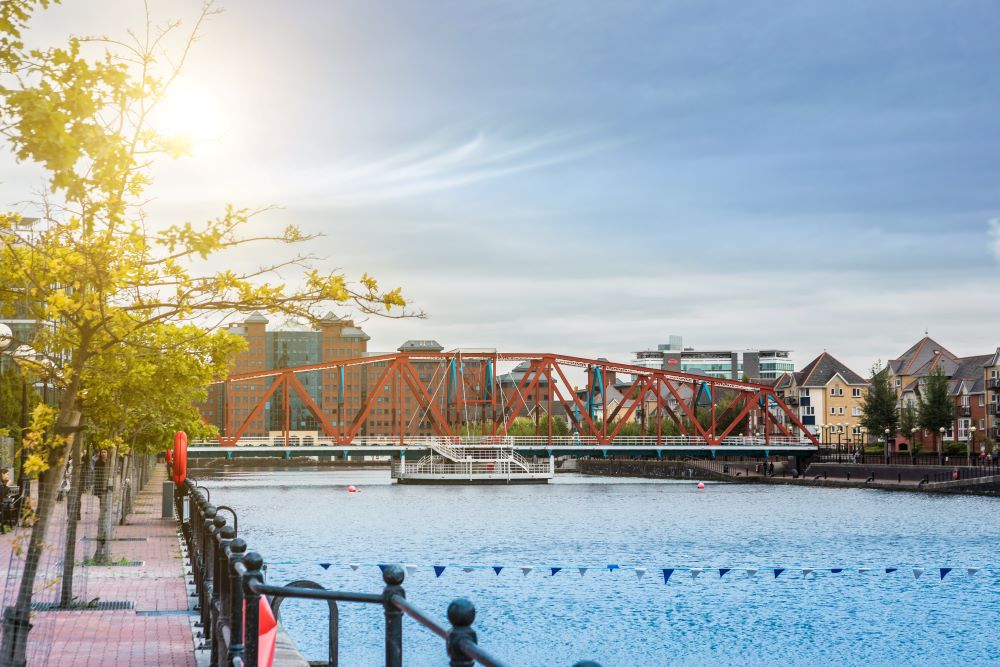
Tree-lined streets are cooler
With these recent scorching summers, we need all the cooling we can get.
In my neighbourhood, which is a reasonably typical urban area in Wigan (with around 60% concrete cover), walking in up to 40°c heat on concrete pavement and a busy road with no trees was absolutely stifling. It was almost unbearable! And I’m fairly young fit and able.
And it’s a known fact, these hot summers are occurring more and more frequently.
Almost all the hottest summer days on record from the past 100 years are from 2018 onwards, which is alarming!
Trees provide shade and reflect some of the sun, and so reduce the ambient temperature.
A new study showed that urban trees in European cities could reduce the temperature by 0.4 degrees and potentially reduce heat-related deaths by 39.5%! That is astounding.
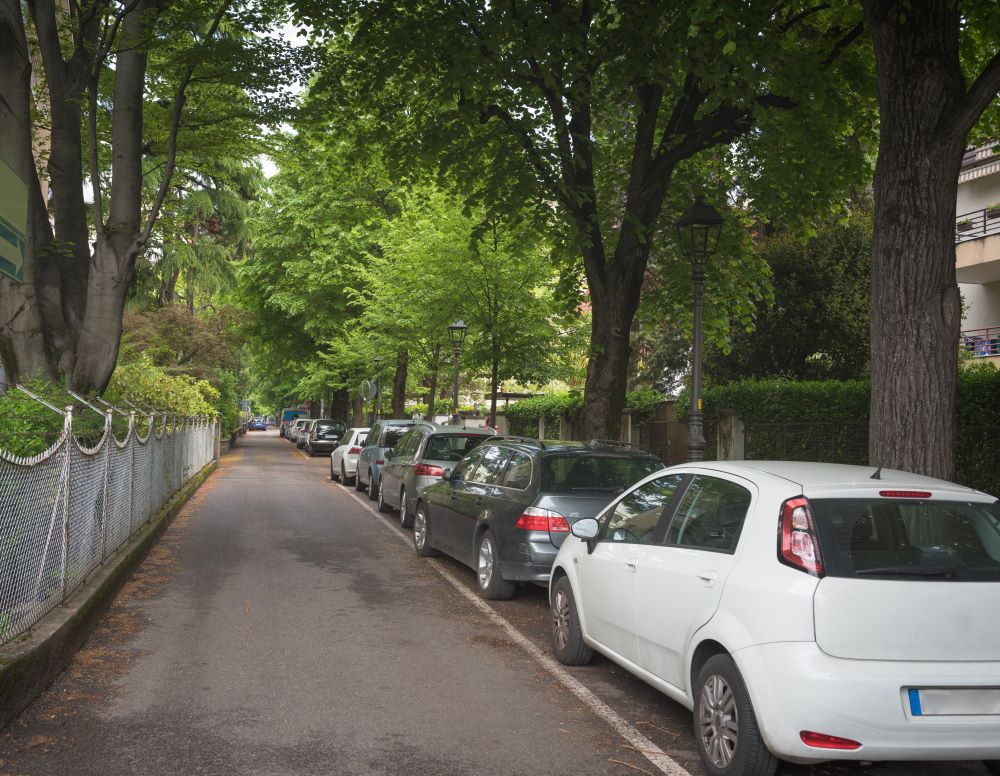
Air quality
This is considered a contentious subject in Wigan due to the CAZ scheme. I wont go into that. But air quality here does need addressing as it does UK-wide, and trees can help this.
There aren’t enough monitoring stations (just 2 in Wigan borough), so the data we have isn’t a complete picture. From the available data, there have been improvements in air quality; however, several areas within Wigan borough are still above the annual air quality levels recommended for NO2.
The UK government recently estimated that long-term exposure to man-made air pollution in the UK has an annual impact on shortening lifespans, equivalent to 28,000 to 36,000 deaths and costing the UK about £20 billion pounds!
And the local picture, the fraction of mortality attributable to human-made particulate air pollution in Wigan is 4.5%
In many cases, the most deprived communities live near the busiest roads, thereby increasing their exposure to pollution. With many areas in Wigan borough being the most deprived in the country, air pollution is hurting our most vulnerable neighbours.
What can trees do? They can form a barrier between the road and people and houses and trap particulate matter from cars on their leaves. They also capture carbon dioxide and produce oxygen, especially bigger older trees. Research has found significantly lower asthma rates among children aged 4-5 in areas with more street trees for example.
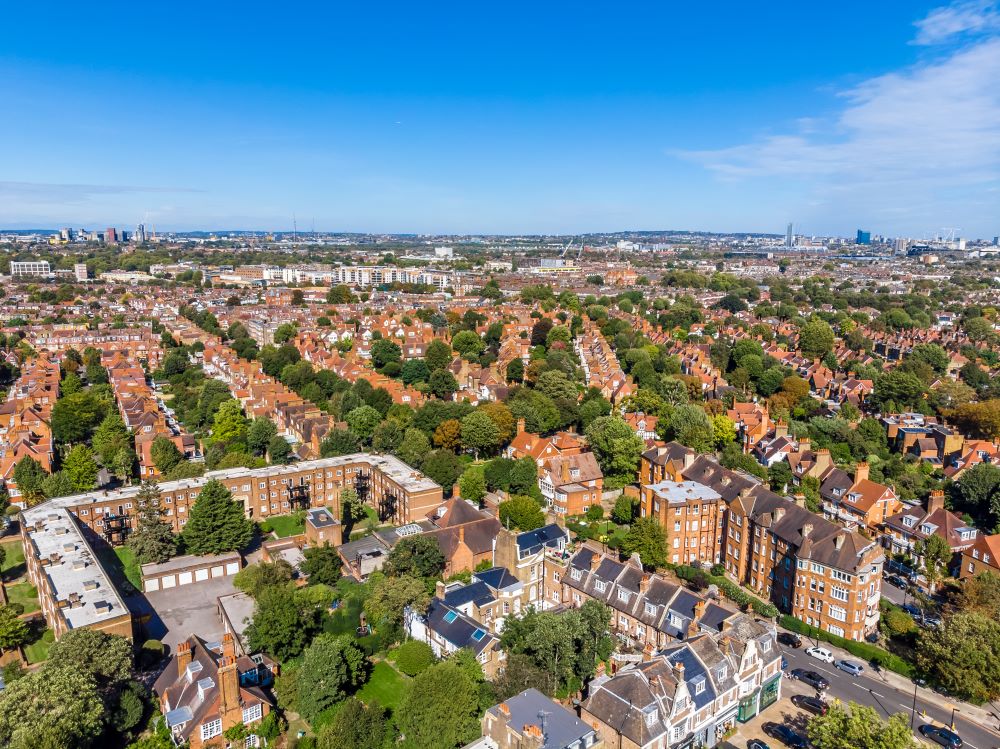
Leaf mulch
In Autumn, inevitably, the leaves on deciduous trees fall to the ground. This is a natural process that’s been happening for millennia and benefits many creatures and the ground below.
Suppose the leaf fall is very heavy by you and causing a nuisance. If you have a garden, or even some decent size containers, Why not make a leaf mulch? All you need to do is a rake and store them all in a pile (with sides to stop them blowing away), or pop it in a bin bag with holes will also do. In time, the leaves break down and create excellent high-quality mulch, which you’d typically pay quite a lot for.
Wildlife
All kinds of creatures depend on trees. Tree-lined streets can act as small wildlife corridors, giving birds a safe spot to stop as they travel. A row of urban trees will create a whole new ecosystem. What particular animals and arthropods are helped really depends on the age and type of tree in situ – but any tree is a benefit over concrete.
Different species of animals will help boost populations of other creatures, but for example, any blossoming trees provide nectar and pollen for all insects, attracting more of them and thus providing more food for birds.
House prices & and Increased spending
Trees are not just great for our health and nature, but Trees within the street layout can increase property values by 5 to 18%. And studies have shown that in shopping streets with trees, people will spend up to 12% more on goods or services in areas with large, well-cared-for trees.
New housing and greenery
Luckily there is some recognition of these benefits. And so in new housing developments, new streets are supposed to be tree-lined or have more trees in their gardens, in line with Biodiversity Net Gain.
But unfortunately, we’ve seen that there are loopholes with this new policy. The new estate is built, and the majority greening parts are offset and done elsewhere. Let’s see how well this new policy actually helps.
Plant your own tree
If your front yard or garden is long enough, why not plant a tree at home. Not all trees will be as huge as the mighty oak and there are plenty that are suitable for gardens, for example magnolia, fruit trees, rowan. wildlife trust have a good guide to smaller native trees for gardens
Ask for street trees
If you’d like more street trees near you, there is a great scheme in the UK called Trees for Streets. Here, you can register your interest and prompt Wigan Council to start planting more street trees in your area. Please sign up and register your interest!
If you would like more information on wildlife gardening, or want to keep up with more of our news, get in touch on either our Facebook page, Instagram, or email

Leave a Reply